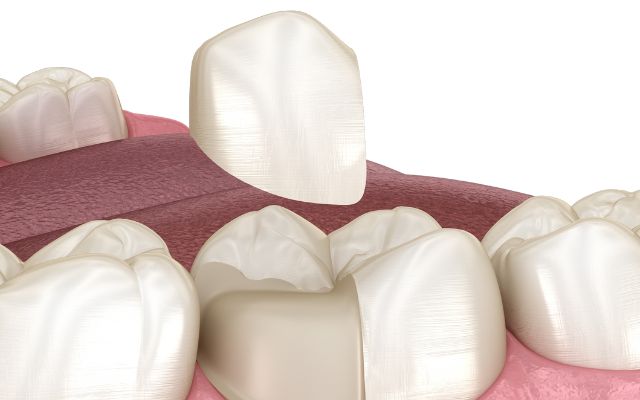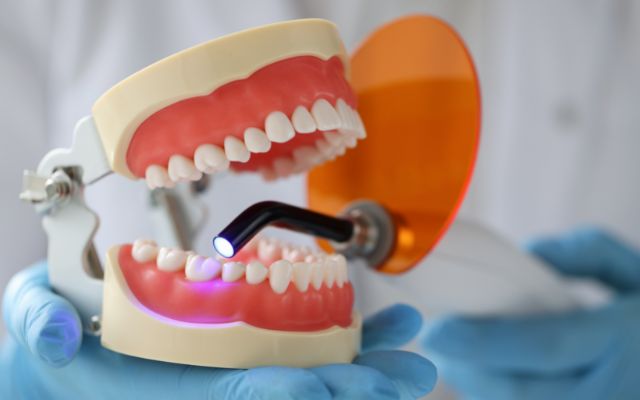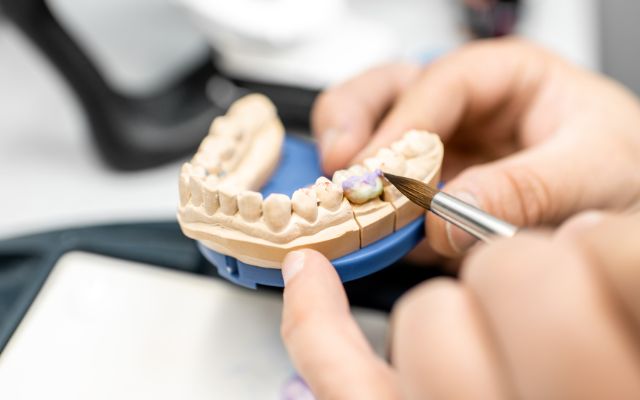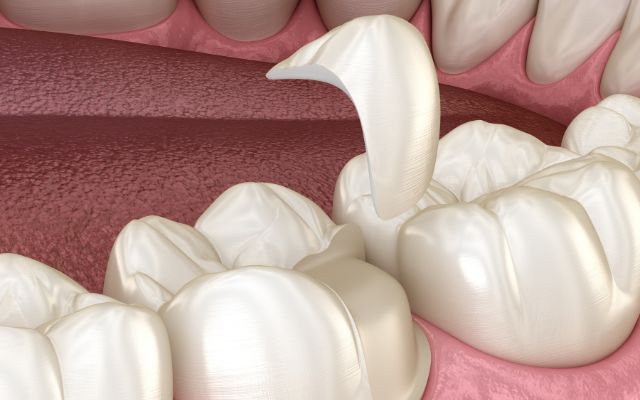Dental Inlays and Onlays
Inlays and Onlays are applied to fill cavities and are subsequently cemented into position in the tooth. What are Inlays and Onlays in dental work? What is the difference between them? In this article, we will explain what is an inlay or onlay and assist you in determining whether an inlay or onlay is the right choice for you. If you need more information, please contact us to set up an appointment.

What is A Dental Inlay?
A dental inlay is a filler that is generally made of porcelain, gold, or resin and is used to treat a cavity. Inlays are larger than fillings but smaller than crowns. An inlay differs from a filling in that it is placed between the cusps on the chewing region of the tooth.
Your dentist will firmly cement it into the tooth when it is created in a skilled dental laboratory.
Inlays Repair Teeth With Large Fillings
Inlays can be used to restore teeth that have big faulty fillings or have been affected by decay or trauma in a conservative manner. Inlays are a great option to silver and composite fillings. Inlays are also less invasive than crowns since less tooth structure is removed during the preparation process.

Inlays Are Durable
Inlays, like the majority of dental restorations, are not necessarily permanent and may eventually need to be replaced. They are extremely sturdy and will last for many years, providing you with a gorgeous, long-lasting smile.
Who Is a Candidate for a Dental Inlay?
- Teeth that are broken or shattered
- Cosmetic improvement.
- Teeth decay.
- Broken fillings.
- Large fillings
What Does Getting An Inlay Inolved?
In most cases, an inlay process involves two appointments. During your initial session, numerous highly exact impressions (molds) will be taken, which will be utilized to produce your bespoke inlay and a temporary repair.
The dentist will eliminate any decay and/or outdated filling materials while the tooth is anesthetized. The area will then be extensively cleaned and meticulously prepped, with the surface shaped to accommodate an inlay repair. While your inlay is being created in a dental laboratory, a temporary filling will be placed to protect the tooth.
Your new inlay will be expertly and precisely positioned at your second appointment. A few tweaks may be required to guarantee a suitable fit and comfortable biting.
Inlays Procedure
At the first appointment
Before taking imprints of the opposing set of teeth, numb the tooth.
Getting down to the natural tooth by removing any decay and any existing fillings, followed by shaping the residual cavity.
Additionally, any tooth fragments that are fragile will be removed by the dentist in order to guard against future fractures in that region.
Taking a final cavity impression.
Taking a bite register will allow you to document how you erupt your teeth. Constructing a temporary. This can be accomplished by using the impression made prior to the preparation of the tooth.
At the second appointment.
The tooth will have to be numbed again.
The temporary is eliminated, frequently by flicking it out with some pressure from a hand tool and a scaler.
The temporary cement is then completely removed, rinsed, and dried from the tooth. The dentist will then test the inlay or onlay to see how it fits and makes contact with the nearby teeth.
Other materials require a number of processes, including prepping the tooth and the inside of the porcelain before gluing them together.
Finally, your bite will be modified such that it feels comfortable and that all of your other teeth meet normally.
What Is A Dental Onlay?
A dental onlay is a type of treatment used to restore damaged or diseased teeth. Onlays are furthermore created in a dental lab using impressions of your teeth. They are firmly anchored in the cavity.
Dental onlays, crowns, and bridges can be used to repair damaged teeth. Because of advances in dental materials technology, we can now give patients with teeth that look, feel, and behave just the same as natural teeth. When a tooth is injured, the damaged parts might be removed by the dentist. At this point, an impression of the injured area is obtained so that a dental laboratory may create the appropriate restoration for you.
Porcelain Onlays
An onlay restoration is a one-of-a-kind filling constructed of composite, gold, or tooth-colored porcelain. Because they seem like genuine teeth, porcelain onlays are popular. Onlays are commonly referred to as partial crowns. Your dentist bonds a porcelain onlay permanently to the tooth after having it produced in a qualified dental laboratory.

Onlays Requirements
The patient’s native tooth structure must be strong enough to sustain the onlay. Onlays can conceal up to three-quarters of a natural tooth. A dental crown is preferable if the tooth has been compromised by a fracture or decay and has lost some of its structural integrity.
Onlays Lifetime
Onlays typically have a lifespan of 10 to 15 years. Onlays, like many other dental restorations, do not endure forever and may need to be updated at some stage. They are, nevertheless, incredibly sturdy and long-lasting, giving you a gorgeous smile.
Who Is a Candidate for a Dental Onlay?
- When a tooth’s cusp is destroyed, an inlay or filling cannot be used.
- If a normal filling is used to treat a cavity on a tooth that has a weak structure and could crack as a result.
- To avoid removing as much natural tooth structure as is typically necessary to place a crown.
Onlays As A Conservative Treatment On Chewing Surfaces
Onlays can be used to restore teeth that have big faulty fillings or have been affected by decay or trauma in a conservative manner. Because onlays require less tooth structure to be removed during preparation than crowns (caps), they are a great alternative to crowns. Onlays are nearly identical to inlays, with the exception that the restoration must additionally include one or more chewing cusps because they have also been harmed.
Onlays Procedure
An onlay process typically necessitates two appointments.
1. First Onlay Mold Appointment
During your first appointment, numerous highly exact impressions (molds) will be taken, which will be utilized to create your bespoke onlay and a temporary restoration.
The dentist will do interdental cleanings, eliminate any decay and/or outdated filling materials while the tooth is anesthetized. The area will then be extensively cleaned and meticulously prepped, with the surface shaped to match an onlay repair. While your onlay is being created in a dental laboratory, a temporary filling will be put to safeguard the tooth.
2. Second Cementing Onlay Appointment
Your new onlay will be expertly and precisely positioned at your second appointment. A few tweaks may be needed to provide a correct fit and a comfortable bite.
Following your treatment, you will be given care instructions. Good oral hygiene, a healthy diet, and frequent dental checkups will extend the life of your new onlay.
Why Porcelain Inlays and Onlays?
Because only a little amount of tooth structure is removed, partial Inlays and Onlays are a more conservative restorative option than a full-coverage dental crown. A dental inlay is placed ‘in’ the tooth, whereas a dental Onlay is placed ‘on’ or over the tooth.

Inlays are intended for usage on teeth that are significantly broken down or worn. Onlays, however, are intended to replace more of the tooth for increased protection.
Inlays & Onlays are made to be used in places like premolar and molar teeth, which experience heavy chewing and grinding forces. Teeth that have broken or suffered minor damage in an accident or athletic injury can also be repaired using Inlays and Onlays.
The Benefits of Dental Inlays and Onlays Dentistry:
- Boost a tooth’s durability in relation to fillings.
- Replacement for a crown in cases where tooth damage is not severe.
- Porcelain Inlays and
- Onlays do not fade over time.
When compared to amalgam fillings, it has a more aesthetically pleasing appearance.
Inlays Vs Onlays: the Difference
An inlay is usually smaller than an onlay.
Inlays are utilized to fill up gaps between the cusps of teeth.
When the surface structure of a tooth and one or more cusps are damaged, a dental onlay is used to bridge the gap.
Onlays and Inlays at Spring Orchid Dental
Your tooth’s functioning and look can both be restored with Inlays and Onlays, allowing you to smile with confidence.
Inlays and Onlays might be the best choice for you if you wish to replace an outdated dental aesthetic or cure a broken or rotting tooth.
We are happy to have you visit Spring Orchid Dental i Bassendean, Perth so that we can find out onlays or inlays choice is best for you.
FAQs
Is An Inlay And Onlay The Same As A Filling?
Inlays are for larger cavities, though they can also be utilized interchangeably. While both remove existing decay, they differ in how the vacant space is replaced. A filling uses a composite material to fill the area, and it is a rapid technique that occurs in a single visit.
Are Onlays Cheaper Than Crowns?
The prices are comparable, although an onlay is slightly less expensive than a crown. As a result, when practicable, an onlay is the ideal restoration. The problem is that an onlay is more difficult to perform correctly and depends more on the dentist’s expertise.
How Much Tooth Is Needed For An Onlay?
The patient’s native tooth structure must be strong enough to sustain the onlay. Onlays can be used to cover up to three-quarters of the natural tooth. A dental crown is a preferable alternative if a fracture or decay has weakened the tooth and compromised its structural integrity.
Are Onlays Painful?
Following the crown or onlay, some discomfort in the area is probable. A few weeks after treatment, the tooth and surrounding tissues may occasionally continue to hurt depending on the situation.
How Soon Can You Eat After An Onlay?
Nothing should be consumed or consumed until the anesthesia has worn off. Furthermore, no hard foods (such as nuts) should be consumed for 24hrs after the dental inlay has been done. Any discomfort after these 24 hours should be discussed to the dentist.





